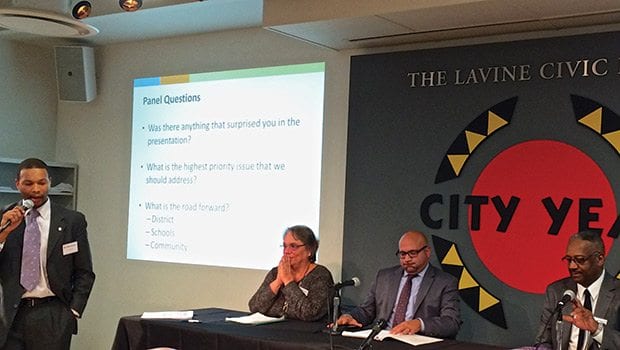Dismay, call to action after ‘sobering’ school report details racial disparities

Following last week’s release of a Boston Public Schools report revealing deep disparities in outcomes for black and Latino males in the Boston schools, community members raised questions and voiced a mixture of emotions and thoughts from dismay and anger to suggestions and passionate hope for change.
About 250 people filled a room Thursday evening at City Year headquarters in Boston to hear findings from the report, an analysis of BPS data from 2009 to 2012 that sheds light on the experience of black and Latino male students. These boys and young men are disproportionately placed into separate special education classrooms, far less likely than white or Asian students to enter the most academically rigorous programs and competitive exam schools, more likely to be suspended in middle school and to drop out of high school, and less likely to show proficiency on MCAS math and English language arts measures.
“It is step up time for everybody in the room,” said Ron Walker, executive director of the Coalition of Schools Educating Boys of Color. “I’m an old head, and I’m shaking my head when I hear some of this stuff, because I’ve been in the room before.”
Kim Janey, senior project director at Massachusetts Advocates for Children, said the report was, in a word, sobering.
“It’s very sobering, but it’s not new,” Janey said. “It highlights inequities that have been around for decades — for example, that black boys are being placed in substantially separate classrooms. Research shows that students do better in inclusive classrooms. We need to make sure students get the services they need, but are also learning alongside their peers.”
At the event, the city’s Chief of Education Rahn Dorsey said, “I was struck by the blunt characterization of a two-track system, one that affords opportunity predominantly for white and Asian males and less opportunity for black and Latino males. It made me bristle. …. The groundbreaking work in front of us is to figure out methods by which we undo structural bias.”
Monica Cannon of Roxbury has two sons in a BPS high school and a daughter in a BPS middle school. She can list many reasons boys of color tend to have a less positive experience in school: lack of mentors and role models, lack of teachers who look like them, failure by schools to ensure families are getting program information, peer pressure to get involved in illegal activities, having to navigate through unsafe neighborhoods, and all-too-frequent assumptions by police that they are troublemakers.
“There should be networks of successful men of color who are not gang-related. There should be mentoring programs in every school so they can see something different. It takes seeing these things to be more positive,” she said.
Cannon drives her kids to school to ensure their safe passage. Through her job and active roles in several community organizations, she feels she has more resources and is able to stay more informed about schools and programs than many parents.
“Some parents work several jobs,” she said, “and the children have to go to school on their own. They face so much peer pressure on their way to school, and that can have a big effect on school. [School officials] have to realize a lot of these black and Latino kids are dealing with a lot. So many times, no one asks ‘What’s happening at home?’ It all affects how they learn.”
At the report release event, another parent of color stood to say she has “lived through” many of the report findings.
“I have special ed stories; I have an exam school attrition story; I am working now to make sure my older son gets the MassCore curriculum.” MassCore is a recommended set of courses to prepare students for four-year colleges, but is not required for a BPS diploma. Not all high schools offer the curriculum. The report shows that less than 20 percent of black and Latino students complete MassCore, while roughly half of white and Asian students do.
Reached later by phone, this mother, who preferred her name not be used, said that in second grade her son’s teacher wanted to diagnose him as having Attention Deficit Disorder.
“He was an average second-grader. Impulsive, high energy, needed help being redirected. That’s an average boy,” she said. “So was the classroom geared toward girls who could sit still? I don’t know.” She feels the teacher did not have cultural competence with black boys.
High on her “wish list” for BPS action is comprehensive staff diversity training, from top to bottom. In addition, she said one of the best ways to ensure the study results spur action is to be an involved parent — participate in parent council, school site council, BPS Parent University — and know the school’s principal and call him or her when a problem arises.
“I think parents need to hold BPS accountable for the next steps,” she said. “Parents need to ask principals, what does this mean for my students, and how can we help the school make things better? Dad’s clubs, support groups for single mothers? What can parents do to make sure their kids don’t fall through the cracks?”
The disparity in Advanced Work Class enrollment, which could set Boston third-graders on dual tracks for the remainder of their school years, raises a red flag and warrants a hard look at how families are informed and prepared, researchers said.
“Anytime there’s that drastic a disproportionality, it is a systemic issue,” said Rosann Tung of the Annenberg Institute for School Reform at Brown University, one of the report authors. “So one question is, what schools is the AWC program sited in? And how do families find out about the AWC schools and how to get into the exam schools?”
State Rep. Jeffrey Sánchez of Boston was visibly stunned by the report’s findings.
Speaking as part of a reaction panel discussion, Sánchez expressed pain and disbelief.
“The words ‘exclusion’ and ‘separation’ really get to me personally,” he said. “This is what we have to show for these children? I am a part of this failure.”
Four days after the event, he was still reeling.
“It was like a punch in the face,” he told the Banner. “As a Latino and someone who went through the school system at a difficult time in the city’s history, it hit me personally, because I hoped we would have been over these and on to other things. The study is so glaring. Every time the researcher showed another image of the disparity, I thought, ‘No more!’ It hurt.”
Sánchez is pondering what he can do in the State House to convene a real discussion on how these disparities have come to be and what to do next.
“The high rates of suspension — how does this happen? Are there standards? How are the decisions made, and why the disproportionate impact?” he wondered. “Not only that, the number of black and brown children in substantially separated classrooms, and the high number of English language learners in special ed. How are we there?”
Sánchez believes it is now the entire community’s moral imperative to act.
“The results should mobilize us to make things dramatically better,” he said. “We have to judge ourselves on how we tackle the issues brought to light.”
For more information: Full “Opportunity and Equity” report and related information in English and Spanish: http://bostonpublicschools.org/opportunity; BPS Special Education Parent Advisory Council: http://bostonspedpac.org; Advanced Work Class and AWC English- and Spanish-language eligibility tests: http://bostonpublicschools.org/Page/659; Parent University: http://bpsfamilies.org/parentuniversity.






